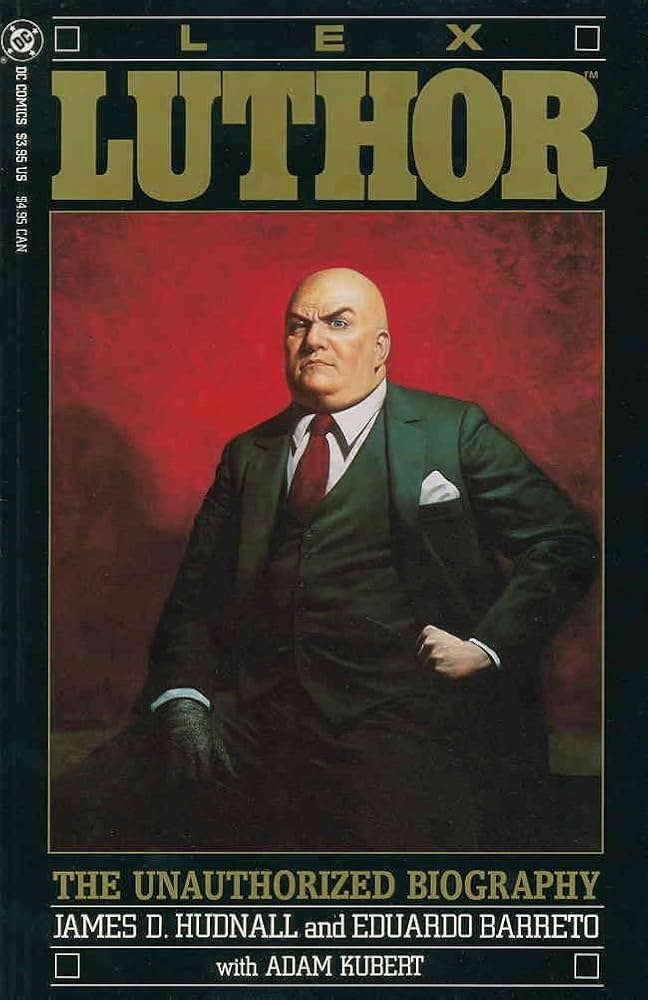
Luthor: If God is all-powerful, He cannot be all good...
“If God is all good, he cannot be all powerful, and if he is all powerful, then he cannot be all good”
Editor's note: This a #retro-post and an article first appeared in our old website snd-revival and it will be reposted here due to the relevence of the topics. This was written more than ten years ago and does not contain new information since then.
Luthor: If God is all-powerful, He cannot be all good...
“In fact I have no doubt... I'll rise from the ashes again” – Michael Rosenbaum as Lex Luthor.
In 1940, in issue 23 of a new superhero comic book series, the arch-enemy of the most powerful man in the world arrived. Jerry Siegel and Joe Schuster created the powerful Lex Luthor.
Luthor has been re-created in various ways, but the image and legacy he has had for the last sixty-six years has almost always been respected. Unlike other villains who have been famous for their picturesque appearance of madness, or some genetic modification, or some power that has turned them into criminals, Luthor has not been the typical villain who has met these (practically) standards of conversion to evil. Luthor can be said to be one of the few villains in superhero stories who have remained faithful to a reality that many lovers of genres far removed from fantasy and unreality love so much.
DC, like Schuster and Siegel, has delighted us with a great story of a man who, despite coming from nowhere, has become one of the most powerful men in the world. But originally, up until the present day, the character of Lex Luthor has undergone several changes and alterations that do not make clear his rise from the beginning of his life to his current role as one of the most powerful criminals in the world.
Origins
In the early days of Superman's story, Luthor was created as a mad scientist with red hair. But in later volumes of the story, artist Joe Shuster preferred to portray him as a bald character. During this period, as mentioned above, Luthor was a villain who was a scientist trying to take over the world or terrorize people as one of Metropolis's biggest crime bosses. In the 1960s, a DC series called “DC Multiverse” featured Lex Luthor (new and now bald) as the alter ego or counterpart of the red-haired scientist Lex Luthor. During this period in the 1960s, the origin of Lex Luthor was revealed.
Jerry Siegel wrote a series called Adventure Comics, which revealed Lex Luthor's origin during the Silver Age. Until this time, the villain was only known as Luthor, and it was not until the emergence of Adventure Comics that he was given the name “Lex.”
During Lex's youth, or rather adolescence, he arrived in the quiet Kansas town of Smallville. During this time, Lex became friends with the local hero, Superboy. In gratitude for his friendship and respect, Superboy built Lex a laboratory where he could search for a cure or immunity to kryptonite and seek to create artificial intelligence. One day, there was an accident in Lex's laboratory. When Superboy arrived to try to put out a fire, he used his ice breath, destroying everything Lex had worked on. Lex took this as an insult and an attempt by Superboy to humiliate him.
Between the 1970s and 1980s, Luthor seems to take a different path. This is notable in his appearances in stories and in the book The Last Son of Krypton by Elliot S. Maggins. It can be inferred from these stories that Lex was a good person. One example of this can be found in 1983, where in Adventure Comics #544, Lex is revered as a hero for rescuing a civilization using alien technology and thus saving the people. But this technological development allowed Lex to create a suit capable of fighting Superman in hand-to-hand combat.
Silver and Bronze eras
In DC's Bronze and Silver Ages, Luthor takes on a slightly more significant role as a villain who tries to conquer the world. Luthor in this era is also recognized as a person who helps the community in times of need, that is, Luthor clearly contributes to technological advancement, the modernization of the city of Metropolis, scientific advances in the DC Multiverse, and of course, he has contributed to providing jobs for the people of Smallville and Metropolis. He was last seen during this period due to his supposed downfall in Crisis on Infinite Earths, a series in which Lex allies himself with Brainiac, another extraterrestrial supervillain (who is possibly the most intelligent mind in the universe), to recruit a series of supervillains from the DC Multiverse. During this period, it was also revealed that Lex has a sister named Lena Thorul. The surname Thorul comes from an anagram of the surname Luthor, as Lex's parents and relatives decided to change their surname so as not to be related to Lex.
Times Change
In the late 1980s, John Byrne and Marv Wolfman came up with the idea of a villain who would truly be different from what we normally know, a villain who would truly make a difference in everyone's lives.
"The Villain of the Story"
The idea we now know as Lex Luthor. A criminal mind shaped by his corporate ingenuity and his power struggle against the state and the world. One of this villain's new ideas returns to the graphic novel (of great quality) by James Hudnall and Eduardo Barreto. The Unauthorized Biography of Lex Luthor became one of the graphic novels that explains Lex Luthor's origins and some details of his life that are not generally known to fans of the story of the Last Son of Krypton.

This volume reveals details such as the fact that Lex murdered his parents for insurance money, which he used to get ahead thanks to his true genius, as he was simply a prodigy. Lex also contributed to heroin trafficking in the United States during the Vietnam War. And he has things to hide from his past that are being revealed by a coworker of Clark Kent, who reveals that he was investigating Luthor and was mysteriously murdered in his flat. However... what else does Lex Luthor have to hide?
After the death of his parents, Lex was placed in a foster home. Alexander Joseph Luthor was the name of the boy who was born and raised in Suicide Slums. This young man, now old enough to access bank accounts and his parents' life insurance money, wanted to leave his adoptive family, with whom Lex was in love with Lena. When Lena's father and Lex's stepfather realized that Lex was hiding bank account paperwork, he demanded that his daughter Lena seduce Lex into handing over everything. But Lena refused to do this because she loved Lex and ended up being beaten to death by her father. When he came home and found his beloved beaten to death by his father, he had an epiphany and swore to himself that he would rise to power and eliminate anyone who stood in his way. Over the next few years, Lex planned the murder of his stepfather and then killed his friend's wife after getting her pregnant because he felt it was her fault that Lena had died. From then on, Luthor stood alone, and nothing and no one could stop him from reaching the top.
Ascension to Power
Over the years, various versions have been created of how Lex Luthor became the powerful criminal he is today. It is said that after receiving the money from his parents' death, Lex waited a while before accessing the money, and then used it to found a technology corporation called Lexcorp. Supposedly, Luthor became the most powerful businessman in Metropolis as well as the most powerful man in organized crime. Ultimately, it is said that Lex Luthor rose to power thanks to a combination of his ingenuity and his money. Today, versions say that Lex Luthor has been solely the product of great entrepreneurial ability. Recent versions, such as the Smallville story, are that Lex only faces a series of tests imposed on him by his father Lionel Luthor, who in these versions is said to have murdered his parents and used the money to start LuthorCorp. But according to the story by James Hudnall and Eduardo Barreto (“The Unauthorized Biography of Lex Luthor”), Luthor is the one who has risen and ascended to power on his own, from the dark and hybrid neighbourhoods of Suicide Slums to the business centres of Metropolis.
Life or Power
During the 1990s, there was a cyborg named Metallo that was made of kryptonite architecture. Before he could kill Superman, he was captured by Lexcorp, and Luthor obtained a small fragment of kryptonite, which he used to make a ring.
Luthor was constantly exposed to radiation from this ring, which caused him to develop a lethal cancer. Until these editions of the Man of Steel story, the idea of the effects of kryptonite radiation on non-Kryptonian beings had not been explored.
During this time, Lex had been experimenting with cloning. Upon discovering that it was successful, he faked his death in a plane crash and used a clone of himself to transplant his brain, which was now in a healthy body with thick red hair and a beard.
Luthor for President
In 2000, Luthor won the White House by advocating national unity and promising a better nation with superior technology. Despite his strong support, Lex also had to deal with problems again against heroic identities. During his term, Luthor was also recognized for his help in rebuilding Gotham City. Despite the arduous battles against the JLA, Luthor had a great battle to fight in which he was supported and emerged as a complete success. This was in the ten-volume series Our Worlds at War. In it, he contributed to the fight against Imperiex, the villain of the Crisis series.
But during his aid to Gotham City, Luthor failed to deliver on all his promises during the reconstruction of the abandoned city. Because of this failure, Bruce Wayne severed all ties with the US government, angering Luthor and causing him to frame Vesper Fairchild, Bruce Wayne's lover at the time, for murder.
As President of the United States, Lex gained access to information classified as Top Secret (i.e., secret files). In 2002, Lex was given a secret file showing the ship that crashed on a small farm in Smallville, Kansas, the farm of Jonathan Kent and Martha Clark Kent.
Luthor couldn't believe this, so he had the scientist killed and decided to keep it a secret, ironically. Also ironically, Lex Luthor helped Superman defeat Manchester Black from Our Worlds At War (a man who had great telepathic powers with abilities so great that he gave Superman a stroke). As revenge, Manchester Black erased all memory of Lex knowing Clark Kent's identity.
Able to frame Bruce Wayne for the murder of Vesper Fairchild, Lex attempted to frame Superman for a meteorite heading toward Earth and also tried to sow doubt in Batman's mind by trying to convince him that his parents had been killed by Metallo. During a battle in which Luthor wore a suit of apocalyptic origin (Apocalypse) and the super steroid (Venom, also used by Bane, the man who broke Batman's back in the Knight Fall series), Lex confessed to several crimes, which were recorded, forcing Lex Luthor to step down from the presidency and handing over power to his vice president Pete Ross, who later handed power over to
Johnathan Horne. Furthermore, he left LexCorp in the hands of the company's new president, Talia Head, who sold all the shares to the Wayne Foundation.

Now and the future
Lex Luthor is the villain who is most closely tied to reality, leaving aside extraterrestrial technology and similar concepts. Rather, it would be due to his great ingenuity and his great power of manipulation and wealth. In recent stories, he has been played by Michael Rosenbaum in the series Smallville and, more recently, by Academy Award winner Kevin Spacey in the movie Superman Returns, Jesse Eisenberg in Zack Snyder's DC Universe, and Nicholas Hoult in James Gun's DC Universe.
However, despite the great difference between Superman and Lex Luthor, he remains a natural leader and an influence for better or worse. And even if he is like any other villain who gets killed, it is easy to remember Michael Rosenbaum's words:
“And I have no doubt... that I will rise from the ashes again.” And personally, he teaches us to be the best we can be, no matter who gets in the way, no matter what stands in our way... “Defeat is not an option.”
Our Comics Newsletter
Join the newsletter to receive the latest updates in your inbox.



